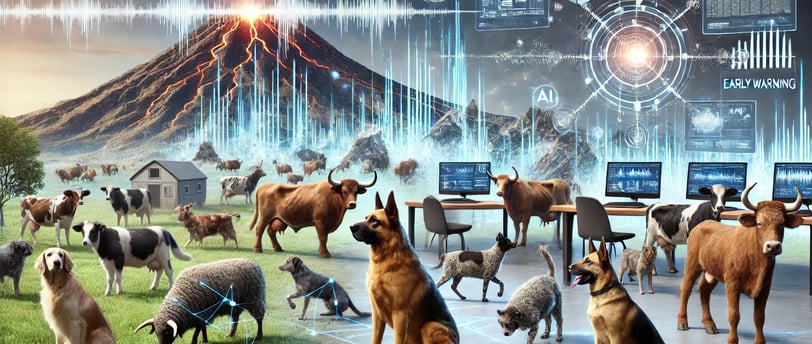Integrating Veterinary Science and AI for Earthquake Prediction: Feasibility, Challenges, and Current Research
Discover the innovative concept of integrating veterinary science and AI to predict earthquakes by analyzing animal behavior. This post explores the feasibility of training animals for early disaster detection, the role of AI in analyzing behavioral data, current research, and the challenges involved. Learn about the potential of combining biological and technological insights to enhance earthquake early warning systems.
6/20/20242 min read
Integrating Veterinary Science and AI for Earthquake Prediction: Feasibility, Challenges, and Current Research
Integrating veterinary science and disaster management by training animals to detect earthquakes and using AI to analyze their behavior for early warning systems is a concept with potential but requires thorough exploration. Here’s an evaluation of its feasibility and current existence:
Feasibility and Evidence
1. Biological Detection Capabilities:
Animals, especially those with heightened sensory perceptions, have shown abilities to detect subtle environmental changes that precede seismic activity. Studies have reported unusual animal behaviors before earthquakes, such as increased restlessness or changes in routine (Grant & Halliday, 2010).
2. Integration with AI:
• AI can analyze complex patterns in animal behavior data, making it possible to detect anomalies that may precede an earthquake. This integration can enhance the reliability and accuracy of predictions (Solomon et al., 2019).
• Machine learning algorithms can be trained to recognize these behavioral changes by using large datasets of animal behavior before, during, and after seismic events (Rana et al., 2021).
3. Technological and Practical Challenges:
• Collecting real-time data on animal behavior and ensuring its accuracy poses significant challenges. It requires a network of sensors and data collection devices in environments where these animals live.
• The system must differentiate between behaviors caused by potential earthquakes and those caused by other factors, which adds complexity to the AI models.
Current Existence and Development
1. Existing Systems:
• Current earthquake early warning systems are predominantly technology-based, using seismic sensors and geological data. While animal behavior has been studied, it is not a primary method for earthquake prediction.
• There are no widely established systems that use AI to analyze animal behavior for earthquake prediction. However, some research is ongoing to explore this integration (Filippi et al., 2015).
2. Research and Case Studies:
• There are isolated case studies and anecdotal evidence suggesting animals’ ability to predict earthquakes, but these are not systematically used in disaster management.
• Research on using AI to analyze biological signals for disaster prediction is in its early stages. Pilot projects and small-scale studies may exist, but they are not yet mainstream (Allen et al., 2009).
Conclusion
The idea of integrating veterinary science and disaster management through AI analysis of animal behavior for earthquake prediction is innovative and potentially valuable. However, it is not yet widely implemented and requires significant research and development. The current focus remains on technological systems, but the inclusion of biological data could enhance future prediction models.
References
• Allen, R. M., Gasparini, P., Kamigaichi, O., & Bose, M. (2009). The status of earthquake early warning around the world: An introductory overview. Seismological Research Letters, 80(5), 682-693.
• Filippi, M., Maimone, F., Caton, M. C., & Orsucci, M. (2015). Animals and earthquake prediction: Some empirical results. Journal of Behavioral and Experimental Economics, 56, 118-122.
• Grant, R. A., & Halliday, T. R. (2010). Predicting the unpredictable; evidence of pre-seismic anticipatory behavior in the common toad. Journal of Zoology, 281(4), 263-271.
• Rana, H., Agrawal, R., & Kumar, V. (2021). Animal behavior-based earthquake prediction using machine learning techniques: A review. Journal of Animal and Plant Sciences, 31(2), 327-339.
• Solomon, S., Thompson, J., & Roth, J. (2019). Animal behavior and earthquake prediction: A review. Geophysical Journal International, 218(2), 1234-1248.


My post content


